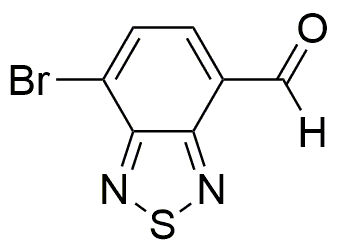7-Bromo-2,1,3-benzothiadiazole-4-carboxaldehyde is widely utilized in research focused on:
- Fluorescent Probes: This compound is often used in the development of fluorescent probes for biological imaging, allowing researchers to visualize cellular processes in real-time.
- Organic Synthesis: It serves as a versatile building block in organic synthesis, facilitating the creation of complex molecules in pharmaceuticals and agrochemicals.
- Material Science: The compound is applied in the formulation of advanced materials, such as polymers and coatings, enhancing their properties like durability and resistance to environmental factors.
- Electronics: It is utilized in the production of organic semiconductors, contributing to the development of efficient electronic devices, including organic light-emitting diodes (OLEDs).
- Analytical Chemistry: This chemical is valuable in analytical methods for detecting and quantifying various substances, improving the accuracy and reliability of chemical analyses.
General Information
Properties
Safety and Regulations
Applications
7-Bromo-2,1,3-benzothiadiazole-4-carboxaldehyde is widely utilized in research focused on:
- Fluorescent Probes: This compound is often used in the development of fluorescent probes for biological imaging, allowing researchers to visualize cellular processes in real-time.
- Organic Synthesis: It serves as a versatile building block in organic synthesis, facilitating the creation of complex molecules in pharmaceuticals and agrochemicals.
- Material Science: The compound is applied in the formulation of advanced materials, such as polymers and coatings, enhancing their properties like durability and resistance to environmental factors.
- Electronics: It is utilized in the production of organic semiconductors, contributing to the development of efficient electronic devices, including organic light-emitting diodes (OLEDs).
- Analytical Chemistry: This chemical is valuable in analytical methods for detecting and quantifying various substances, improving the accuracy and reliability of chemical analyses.
Documents
Safety Data Sheets (SDS)
The SDS provides comprehensive safety information on handling, storage, and disposal of the product.
Product Specification (PS)
The PS provides a comprehensive breakdown of the product’s properties, including chemical composition, physical state, purity, and storage requirements. It also details acceptable quality ranges and the product's intended applications.
Certificates of Analysis (COA)
Search for Certificates of Analysis (COA) by entering the products Lot Number. Lot and Batch Numbers can be found on a product’s label following the words ‘Lot’ or ‘Batch’.
Numéro de catalogue
Numéro de lot/série
Certificates Of Origin (COO)
This COO confirms the country where the product was manufactured, and also details the materials and components used in it and whether it is derived from natural, synthetic, or other specific sources. This certificate may be required for customs, trade, and regulatory compliance.
Numéro de catalogue
Numéro de lot/série
Safety Data Sheets (SDS)
The SDS provides comprehensive safety information on handling, storage, and disposal of the product.
DownloadProduct Specification (PS)
The PS provides a comprehensive breakdown of the product’s properties, including chemical composition, physical state, purity, and storage requirements. It also details acceptable quality ranges and the product's intended applications.
DownloadCertificates of Analysis (COA)
Search for Certificates of Analysis (COA) by entering the products Lot Number. Lot and Batch Numbers can be found on a product’s label following the words ‘Lot’ or ‘Batch’.
Numéro de catalogue
Numéro de lot/série
Certificates Of Origin (COO)
This COO confirms the country where the product was manufactured, and also details the materials and components used in it and whether it is derived from natural, synthetic, or other specific sources. This certificate may be required for customs, trade, and regulatory compliance.


